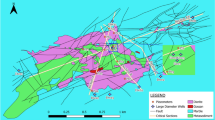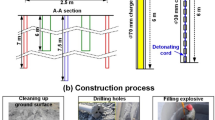Anisotropic strata are frequently encountered in deep drilling engineering, especially for the rock with fracture structures. The problem of instability in highly deviated well in this kind of rock stratum is prominent as the strength of fractured rocks is weakened and the directions of fractures, in-situ stress and borehole axis can be complex. A model is built in this paper to assess the safety of drilling considering the influences of well trajectory, in-situ stress and fractures. The results show that: the fractures with different dip angles have important influence on the failure area and the collapse pressure. It is quite necessary to select the safe drilling trajectory in fractured formations as this is the economical and convenient approach. For some directional drilling, the determination of safe mud weight should be cautious. The in-situ stress difference, pore pressure and fracture strength parameters have significant effects on well collapse pressure. The above model calculation under specific working conditions can easily evaluate the safety and stability of wells drilling in all directions in fractured formation, so as to provide reference for well trajectory design of highly deviated wells.








Similar content being viewed by others
References
Bradley, W.B., 1979. Failure of Inclined Boreholes. Journal of Energy Resources Technology 101, 232–239.
Zhou, S., Hillis, R., Sandiford, M., 1996. On the Mechanical Stability of lnclined Wellbores. SPE-28176-PA.
Al-Ajmi, A.M., Zimmerman, R.W., 2009. A new well path optimization model for increased mechanical borehole stability. Journal of Petroleum Science and Engineering 69, 53–62.
Liu, H., Liu, T., Meng, Y., Han, X., Cui, S., Yu, A., 2019. Experimental study and evaluation for borehole stability of fractured limestone formation. J. Pet. Sci. Eng. 180, 130–137.
Lee, H., Ong, S.H., Azeemuddin, M., Goodman, H., 2012. A wellbore stability model for formations with anisotropic rock strengths. J. Pet. Sci. Eng. 96–97, 109–119.
Ma, T., Chen, P., Yang, C., Zhao, J., 2015. Wellbore stability analysis and well path optimization based on the breakout width model and Mogi–Coulomb criterion. J. Pet. Sci. Eng.
Ding, Y., Luo, P., Liu, X., Liang, L., 2018. Wellbore stability model for horizontal wells in shale formations with multiple planes of weakness. J. Nat. Gas Sci. Eng. 52, 334–347.
Cheng, W., Jiang, G., Li, X., Zhou, Z., Wei, Z., 2019. A porochemothermoelastic coupling model for continental shale wellbore stability and a case analysis. J. Pet. Sci. Eng. 182, 106265.
Zamiran, S., Rafieepour, S., Ostadhassan, M., 2018. A geomechanical study of Bakken Formation considering the anisotropic behavior of shale layers. J. Pet. Sci. Eng. 165, 567–574.
Aadnoy, B.S., 1987. Modelling of the Stability of Highly Inclined Boreholes in Anisotropic Rock Formations, in: SPE-16526-MS. Society of Petroleum Engineers, SPE.
Ong, S.H., Roegiers, J.-C., 1993. Influence of anisotropies in borehole stability. Int. J. Rock Mech. Min. Sci. Geomech. Abstr. 30, 1069–1075.
Okland, D., Cook, J.M., 1998. Bedding-Related Borehole Instability in High-Angle Wells, in: SPE-47285-MS. Society of Petroleum Engineers, SPE.
Qi, D., Li, L., Jiao, Y., 2018. The stress state around an elliptical borehole in anisotropy medium. J. Pet. Sci. Eng. 166, 313–323
Li, Y., Weijermars, R., 2019. Wellbore stability analysis in transverse isotropic shales with anisotropic failure criteria. J. Pet. Sci. Eng. 176, 982–993.
Acknowledgments
The authors gratefully acknowledge the financial support of the Project support by China Petrochemical Corporation (No. p21069), the financial support of the National Nature Science Foundation of China (No.52074018), the financial support of fundamental Research Funds for the Central Universities (buctrc202017).
Author information
Authors and Affiliations
Corresponding author
Additional information
Translated from Khimiya i Tekhnologiya Topliv i Masel, No. 3, pp. 85–91 May–June, 2022.
Rights and permissions
Springer Nature or its licensor holds exclusive rights to this article under a publishing agreement with the author(s) or other rightsholder(s); author self-archiving of the accepted manuscript version of this article is solely governed by the terms of such publishing agreement and applicable law.
About this article
Cite this article
Zhao, B., Yu, J., Sun, T. et al. Drilling Safety Assessed by Anisotropic Strength Criterion of Rocks in Deep Fractured Formation: Trajectory Optimization of Inclined Wells. Chem Technol Fuels Oils 58, 511–518 (2022). https://doi.org/10.1007/s10553-022-01415-2
Published:
Issue Date:
DOI: https://doi.org/10.1007/s10553-022-01415-2




